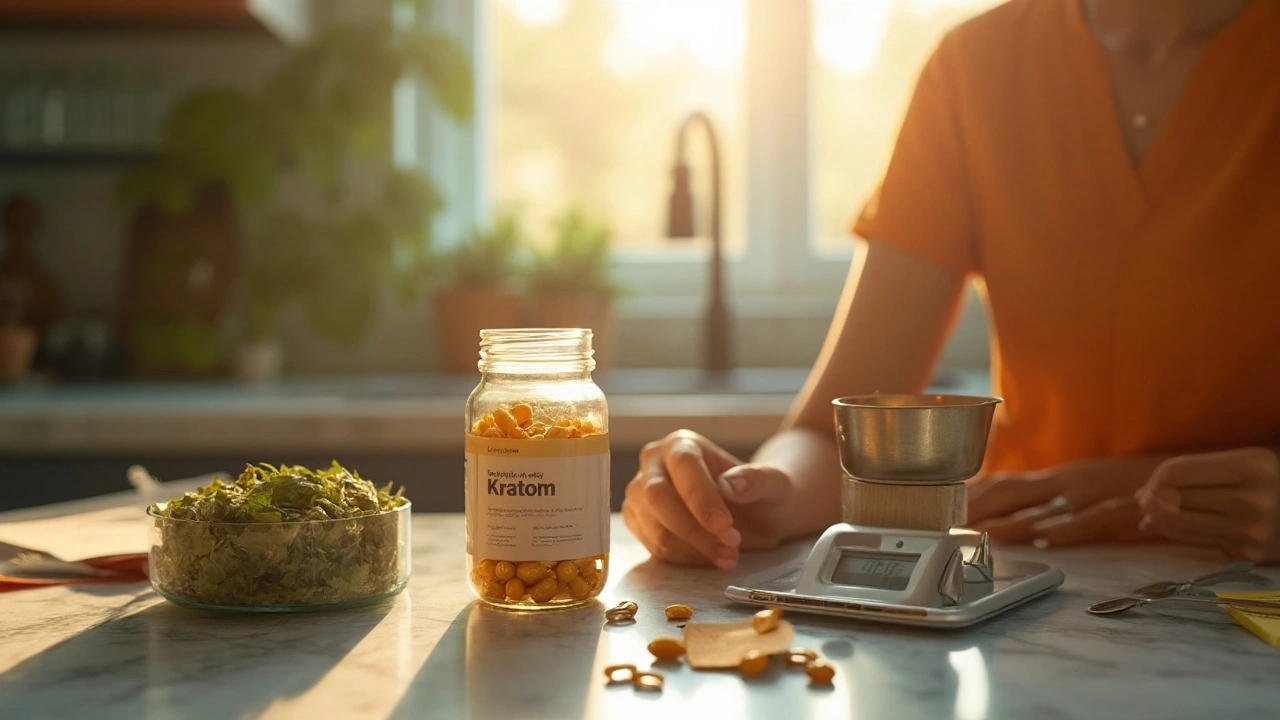You’ve likely heard whispers about kratom-on podcasts, Reddit, maybe even from a friend who ditched their third coffee. Big promise, big debate. Here’s the deal: kratom might be heading for prime time in supplements, but it’s tangled up in legal, safety, and quality questions. I’m writing from Nottingham in the UK, where selling kratom for human consumption is illegal, so I’ll keep this straight: what’s driving the hype, what the evidence actually says, where it’s risky, and how to judge the noise without getting burned.
- Kratom is trending because people want plant-based options for energy, mood, and discomfort-but claims outrun proof.
- Regulators are circling: testing standards are emerging in parts of the U.S.; the UK bans supply for human consumption.
- Early research hints at analgesic and stimulant-like effects, with real risks: dependence, interactions, contamination.
- If you can’t verify legality and lab testing, don’t touch it. Talk to a clinician before any experiment.
- Expect more studies in 2025, not instant clarity. Treat kratom as “interesting, not settled.”
Why Kratom Is on Everyone’s Radar in 2025
Kratom (Mitragyna speciosa) is a Southeast Asian tree. People traditionally brewed the leaves as a tea to fight fatigue and discomfort. Its main alkaloids-mitragynine and 7-hydroxymitragynine-interact with opioid and other receptors, which is why users report both stimulant-like and soothing effects depending on dose, strain, and product. That receptor activity is also why dependence and withdrawal are possible.
So why the surge now? Three reasons. First, consumers want plant-based options that sit somewhere between coffee and pain pills. Second, the WHO’s Expert Committee on Drug Dependence reviewed kratom in 2021 and did not recommend international scheduling, but did recommend monitoring-effectively saying “watch closely.” Third, the U.S. market has seen state-level rules popping up to test and label products. All that keeps kratom in the conversation, even while public-health agencies warn about risks.
Set expectations right. Evidence is early and mixed. Regulatory status is messy. Quality varies wildly. None of this is plug-and-play wellness. Still, the momentum is real, and if you understand the trade-offs, you’ll read the headlines with clearer eyes.
10 Reasons It’s Being Touted as the Next Big Supplement
-
kratom benefits are a hot search topic. Interest is climbing because people want “functional” plants that boost energy or take the edge off. Google Trends and marketplace data show sustained interest in kratom in the last few years, especially in the U.S. and parts of Europe. That demand doesn’t prove efficacy, but it drives investment, research, and better labeling-often the ladder other supplements climbed before going mainstream.
-
Preclinical research is intriguing. University labs have reported analgesic effects of mitragynine in animals with less respiratory depression than classical opioids at comparable effect levels. That nuance matters: “less” doesn’t mean “none,” and rodent data don’t automatically translate to humans. But it’s enough to justify more clinical research, and that research tends to attract funding and smarter product development.
-
Large user surveys suggest real-world use patterns. A 2020 Johns Hopkins Medicine survey of U.S. kratom consumers found many self-reported using it for pain, mood, or to reduce use of other substances. Self-reports aren’t clinical proof, but they point researchers to hypotheses worth testing-like whether kratom’s stimulant-like profile at low serving sizes could substitute for extra caffeine, or whether its soothing profile at higher amounts supports discomfort management in some people.
-
Regulatory frameworks are slowly forming. Several U.S. states have passed versions of a Kratom Consumer Protection Act (KCPA). These laws typically require age limits, contaminant testing, alkaloid disclosure, and clear labels. That structure-similar to rules that stabilized the CBD market-can cut down on adulteration and mislabeling. Where rules appear, product quality tends to improve.
-
The WHO review steadied the conversation. In 2021, the WHO ECDD did not recommend scheduling kratom internationally, citing insufficient evidence. That was not a green light; it was a “keep researching” signal. But it did prompt more grants and less knee-jerk bans in some regions, buying time for better science to land.
-
Testing tech is catching up. Independent labs now quantify mitragynine content by HPLC, screen for heavy metals, microbes, and residual solvents, and flag adulterants. Five years ago, finding a transparent certificate of analysis (COA) for kratom was rare; now it’s becoming table stakes in regulated U.S. states. If kratom continues toward mainstream, testing becomes a gatekeeper for safety.
-
People want alternatives between coffee and pain pills. This is the awkward middle where many turn to off-label hacks. Kratom sits right there in the public imagination: a plant with pep at low amounts and calm at higher ones. Whether that holds up in trials is the big question, but that perceived middle ground is a powerful market force.
-
Policy is more nuanced than “ban or bless.” In the UK (where I am), selling or supplying kratom for human consumption is illegal under the Psychoactive Substances Act 2016. In the U.S., it’s legal federally but restricted or regulated state-by-state. Thailand removed kratom from its narcotics list in 2021 and treats it more like a traditional plant product. This patchwork encourages cautious product innovation instead of a grey-market free-for-all or a total blackout.
-
Consumer media learned from the CBD mess. After years of overhyped wellness claims, reputable outlets now lead with caveats-side effects, dependence risk, interactions, and the reality that some products test dirty. That skepticism helps kratom too: the nonsense gets filtered faster, and the useful signals-dosage forms, testing, honest labels-rose in importance. Expect more scrutiny, not less.
-
More human data is on the way. Agencies like NIDA have funded kratom studies; toxicology groups track exposure reports; and academic centers are preparing observational cohorts. The first randomized controlled trials in specific use-cases are starting to appear. That pipeline is what moved omega-3s, creatine, and melatonin from fringe to mainstream. Kratom won’t sprint there-but the track is laid.
A reality check: risks are not trivial. The U.S. FDA has warned about dependence, withdrawal, and contamination; the CDC has documented kratom exposures and a past Salmonella outbreak linked to kratom products in 2018. Case reports note liver injury in rare instances. Interactions are a real concern because kratom alkaloids are metabolized by CYP enzymes (notably CYP3A and CYP2D6). This is why the hype comes with a bright red asterisk.

Safety, Legality, and How to Judge Quality
If you take one thing from this section, make it this: legality and testing come first. No exceptions.
Legal status shifts, and it’s local. Here’s a snapshot as of September 2025. Always verify with an official source in your area.
| Region/Country | Status (2025) | Notes |
|---|---|---|
| United Kingdom | Illegal to supply for human consumption | Psychoactive Substances Act 2016; simple possession generally not an offense outside custodial settings. |
| United States (Federal) | Not scheduled federally | FDA warns against use; legality varies by state and locality. |
| U.S. States (selected) | Bans in some; regulated in others | Examples: Some states ban sales; others have KCPA-style testing/labeling rules. Check your state law. |
| Canada | Not authorized for human consumption | Health Canada prohibits sale for ingestion; products often labeled “not for human consumption.” |
| European Union | Patchwork | No EU-wide scheduling; several member states restrict or ban sales. Verify locally. |
| Thailand | Decriminalized (2021) | Kratom removed from narcotics list; domestic regulation applies. |
| Australia | Prohibited | Generally treated as a Schedule 9 substance; import and supply banned. |
| New Zealand | Controlled | Regulated under medicines/psychoactive laws; check current classification. |
Safety quick facts (evidence-based, not scare tactics):
- Dependence and withdrawal: Documented. Users report tolerance, cravings, and withdrawal symptoms (e.g., irritability, insomnia, aches) after regular use. Medical case series back this up.
- Liver injury: Rare but real. Case reports link kratom to cholestatic liver injury; most cases resolve after stopping, but don’t assume you’re exempt.
- Drug interactions: Potential with CYP3A/CYP2D6 substrates and CNS depressants. SSRIs, benzodiazepines, certain pain meds, and many others can interact. Talk to a clinician.
- Contamination: Past Salmonella outbreak (CDC, 2018) and sporadic reports of heavy metals and adulterants. Only consider products with recent third-party COAs in places where sales are legal.
- Pregnancy/Adolescents: Avoid. Lack of safety data and higher risk profiles.
- Driving/heavy machinery: Don’t. Impairment is possible.
Quality checklist if (and only if) it’s legal where you live:
- COA within last 6-12 months from an accredited lab, covering identity (mitragynine quant), heavy metals, microbes, and adulterants.
- Plain ingredients. No synthetic “boosters,” no undeclared extracts.
- Clear label: alkaloid content per serving, batch number, warnings, contactable manufacturer.
- Avoid products marketed with disease claims (“treats depression/pain”). That’s illegal marketing and a red flag.
- Start/stop plan discussed with a healthcare professional. No daily, open-ended self-experiments.
Who should not experiment with kratom? Anyone with a substance-use history, liver disease, significant psychiatric conditions, or who’s on interacting meds. If you’re competing under anti-doping rules, steer clear-policies evolve, and contamination risk can end a season.
Think in Systems: A Practical Way to Evaluate Kratom
Here’s a simple mental model to cut through noise without handing you a how-to manual.
-
Map your goal. “I want less afternoon jitter” or “my back hurts after work” are very different jobs. If your goal is clinical (pain, anxiety, substance use), don’t self-medicate-see a clinician first.
-
Check legality. If it’s banned for human consumption where you live (like in the UK), you’re done. Don’t chase loopholes.
-
Screen for conflicts. List your prescriptions, supplements, and conditions. Ask a pharmacist or doctor: any CYP3A/CYP2D6 or CNS red flags?
-
Evaluate alternatives. Could sleep, nutrition, physiotherapy, caffeine timing, magnesium, creatine, or CBT-I solve the same problem with less risk?
-
If still interested and it’s legal, verify testing. No current COA, no purchase. If a brand can’t show batch-level data, walk away.
-
Plan an exit. Any experiment needs a stop date, symptom tracking, and off-ramps. Escalation and daily use are how tolerance and withdrawal sneak up.
Heuristics worth keeping:
- The more dramatic the claim, the worse the product. Real science sounds cautious.
- Daily, indefinite use of psychoactive plants often ends with tolerance. Cycles and breaks reduce risk-if you ever go there under medical guidance.
- “Natural” doesn’t equal “safe.” Digitalis is natural. So is hemlock.
Authoritative sources to watch (no links-search by name):
- WHO Expert Committee on Drug Dependence (2021 review on kratom)
- U.S. FDA communications on kratom products and safety alerts
- CDC reports on kratom exposures and contamination events
- European Monitoring Centre for Drugs and Drug Addiction (EMCDDA) updates
- Peer-reviewed journals in pharmacology and toxicology

Mini‑FAQ, Scenarios, and Next Steps
Common questions I get asked-answered plainly.
-
Is kratom legal in the UK? Selling or supplying for human consumption is illegal under the Psychoactive Substances Act 2016. That’s the practical stop sign.
-
Is kratom “safe”? Not a helpful question. “Safer than what, for whom, and for how long?” is better. Risks include dependence, withdrawal, interactions, and contamination. Some people tolerate it; some don’t. No free lunch.
-
Will kratom help with pain or mood? Maybe, maybe not. Human evidence is limited and mixed. If pain or mood are clinical issues, talk to a clinician before touching kratom. You have better-studied options.
-
Can I mix kratom with alcohol, benzodiazepines, or opioids? Don’t. Combining CNS depressants increases risk.
-
Does kratom show up on drug tests? Policies and panels vary, and products can be contaminated. If your job or sport tests, assume risk.
-
What about “strains” and colors? Marketing categories (red, green, white) are inconsistent across brands. Chemistry matters more than names-mitragynine content and lab tests tell you something; color names don’t.
-
Is “extract” better than “leaf”? Extracts can be far more potent and riskier. More isn’t better-especially with psychoactive plants.
Scenarios and trade‑offs:
-
Desk worker chasing midday focus: You likely need sleep, light, hydration, and caffeine timing-not a psychoactive plant. If you’re still curious and it’s legal where you live, remember that tolerance is common with daily use.
-
Chronic back pain after a car accident: This is clinical. See a pain specialist. Physiotherapy, graded activity, sleep therapy, and certain medications have far more data behind them than kratom.
-
Recovering from substance misuse: Kratom is not a DIY recovery plan. Work with an addiction specialist. The risk curve is too steep to go solo.
-
Athlete in a tested sport: Don’t risk it. Unknowns around contamination and evolving policies can cost you a career moment.
Next steps if you’re still evaluating:
- Write down your goal and your current symptoms or pain points.
- Check your local law using an official source; in the UK, treat kratom as off-limits for human consumption.
- List every medication and supplement you take and run an interaction check with your pharmacist or GP.
- Trial safer, evidence-backed alternatives first (sleep hygiene, physio, CBT-I, nutrition tweaks, caffeine timing).
- If you ever consider kratom where legal, require a recent third-party COA and a clinician’s sign-off. Set a stop date.
Troubleshooting different paths:
-
If you’re feeling worse after starting any new supplement: stop, note your symptoms, and talk to a clinician. Don’t layer more products to fix side effects.
-
If you’ve been using kratom daily and feel stuck: don’t go cold-turkey without medical advice. Withdrawal is real. Speak to your GP or an addiction specialist.
-
If a product lacks a COA or makes disease claims: bin it. That’s the industry telling you it can’t be trusted.
-
If you’re on SSRIs, benzos, stimulants, or pain meds: assume an interaction risk until a clinician says otherwise.
Final thought: The reason kratom might be “next” is the same reason it demands caution. It sits right at the edge of what people want and what science can currently vouch for. That edge can be exciting-and it can cut. Respect the difference.

Lydia Zhang
September 7, 2025 AT 01:28Kay Lam
September 7, 2025 AT 08:04Matt Dean
September 8, 2025 AT 09:03Walker Alvey
September 9, 2025 AT 15:22Adrian Barnes
September 11, 2025 AT 11:47Declan Flynn Fitness
September 11, 2025 AT 21:10